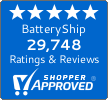|
|
Save 5% Extra Online. Use code: SAV420 |
 |
|
|

|
Save 5% Extra Online. Use code: SAV420
 More Battery Answers
More Battery Answers
What battery chemistry types will I find at BatteryShip
The battery chemistry types we integrate into our batteries are one of the following chemistries: NICD (Nickel cadmium), NIMH (Nickel metal hydride), LI-ION (Lithium Ion), LI-PO (Lithium Ion Polymer), LiMnO2 (Lithium Manganese Dioxide), LiFePO4 (Lithium Iron Phosphate), and LiSOCl2 (Lithium Thionyl Chloride)
IMPORTANT NOTE: While devices and chargers made to use lithium based batteries can use either Lithium-ion or Lithium-ion-polymer (Polymer Lithium) without compatibility issues, chargers made for nickel based batteries are a little tricky. Many devices are made to use Nickel based batteries and can use both Nickel-cadmium and Nickel-metal-hydride without compatibility issues. As far as chargers go, a charger designed only for nickel-metal-hydride can also accommodate nickel-cadmium, but not always the other way around. A charger designed only for nickel-cadmium may overcharge the nickel-metal-hydride battery. Some chargers are designed and specifically labeled to charge both nickel based battery types without issue, and some can even charge all lithium and nickel chemistries.
More Info:
- The lithium-polymer battery differentiates itself from the conventional battery in the type of electrolyte used (a plastic-like film that does not conduct electricity but allows ion exchange - electrically charged atoms or groups of atoms). The polymer electrolyte replaces the traditional porous separator, which is soaked with electrolyte. The dry polymer design offers simplifications with respect to fabrication, ruggedness, safety and thin-profile geometry. Cell thickness measures as little as one millimeter (0.039 inches). Lithium polymer can be formed and shaped in any way imagined. Commercial lithium-polymer batteries are hybrid cells that contain gelled electrolyte to enhance conductivity. Gelled electrolyte added to the lithium-ion-polymer replaces the porous separator. The gelled electrolyte is simply added to enhance ion conductivity. Lithium-ion-polymer greatest market potential is itís wafer-thin geometries used for batteries in PDAs. Lithium polymer also offers improved safety - more resistant to overcharge and less chance for electrolyte leakage.
- Lithium-ion batteries are widely used today since they offer significant benefits for portable consumers. Lithium is the lightest of all metals it has the greatest electrochemical potential, and the largest energy density for its weight. The load characteristics of lithium are reasonably good in terms of discharge. The high cell voltage of 3.6 volts allows battery pack designs with only one cell versus three (less costly and compact). Lithium ion is a low maintenance battery with no memory and no scheduled cycling being required to prolong the battery's life. And finally Lithium-ion cells cause little harm when disposed.
- Nickel-cadmium batteries were first invented in 1899 and are a mature energy type with moderate energy density. Nickel-cadmium is used in batteries where long life, high discharge rate and extended temperature range is important. The main applications for nickel-cadium batteries are for two-way radios, biomedical equipment and power tools.
- Nickel-metal-hydride batteries have a higher energy density compared to nickel-cadmium but at the expense of severely reduced cycle life. Applications include mobile phones, two way radios, and laptop computers..
- For more info please click here .
More Battery Answers

All offers and prices are subject to change without notice.
Privacy Policy
All brand names and trademarks are the property of their respective owners. The listed brand names and model designations are intended only to show the compatibility of these products with various machines. Neither BatteryShip Inc nor BatteryShip.com are affiliated with the original manufacturers of any of these batteries or chargers. All products on this page are generic, aftermarket, replacement parts.
